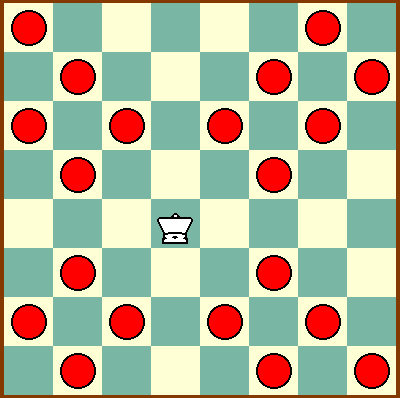Piececlopedia: Duke
Historical notes
The Duke was invented by Eric Greenwood in 1980 for his game RennChess. The Duke is closely related to the Cavalier -- also invented for Rennchess -- which has a historical precedent in the Griffon from Grande Acedrex.Movement
The Duke can move in either of the following ways:
- Step one square orthogonally, and then slide any number of squares diagonally.
- Slide any number of squares diagonally, then step one square orthogonally.
The options given for the Duke's movement both produce the same set of destination sqaures, but give it different paths to those squares.
Movement Diagram
In the diagram below, the Duke can move to any of the squares marked with a red circle. Note that like the Knight, the Duke always moves from a light-colored square to a dark-colored square, and vice-versa.

The diagram to the left below illustrates how the Duke has two different paths to any destination square. If the Duke wishes to move from a1 to e6, he can do so by following either the blue circles or the green circles. As long as one path is open, he can make the journey, even if the other path is blocked.
The diagram on the right illustrates checkmate by Duke. Black can not play Rc3 or Rd3 because it would open a path for the Duke from f1-a5-a6. If black had a knight on b6 instead of a Bishop, however, he could play Nc4, blocking the Duke.


Remarks
The value of the Duke is difficult to judge, but it is a strong piece, probably about the same as a Queen on a larger board. Its unique movement means that it can control a diagonal without actually being on it, which is often useful when an opponent's Bishop is on that diagonal as well. The Duke's biggest weakness is that it can't move to an adjacent square. Like the Bishop, a Duke and a King can not checkmate a lone King, even if the King cooperates.Currently, I do not know of any games other RennChess that use the Duke, but it is a piece worthy of consideration for future games.
This is an item in the Piececlopedia: an overview of different (fairy) chess pieces.
Written by Benjamin C Good.
WWW page created: March 13, 2002.
